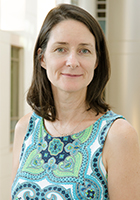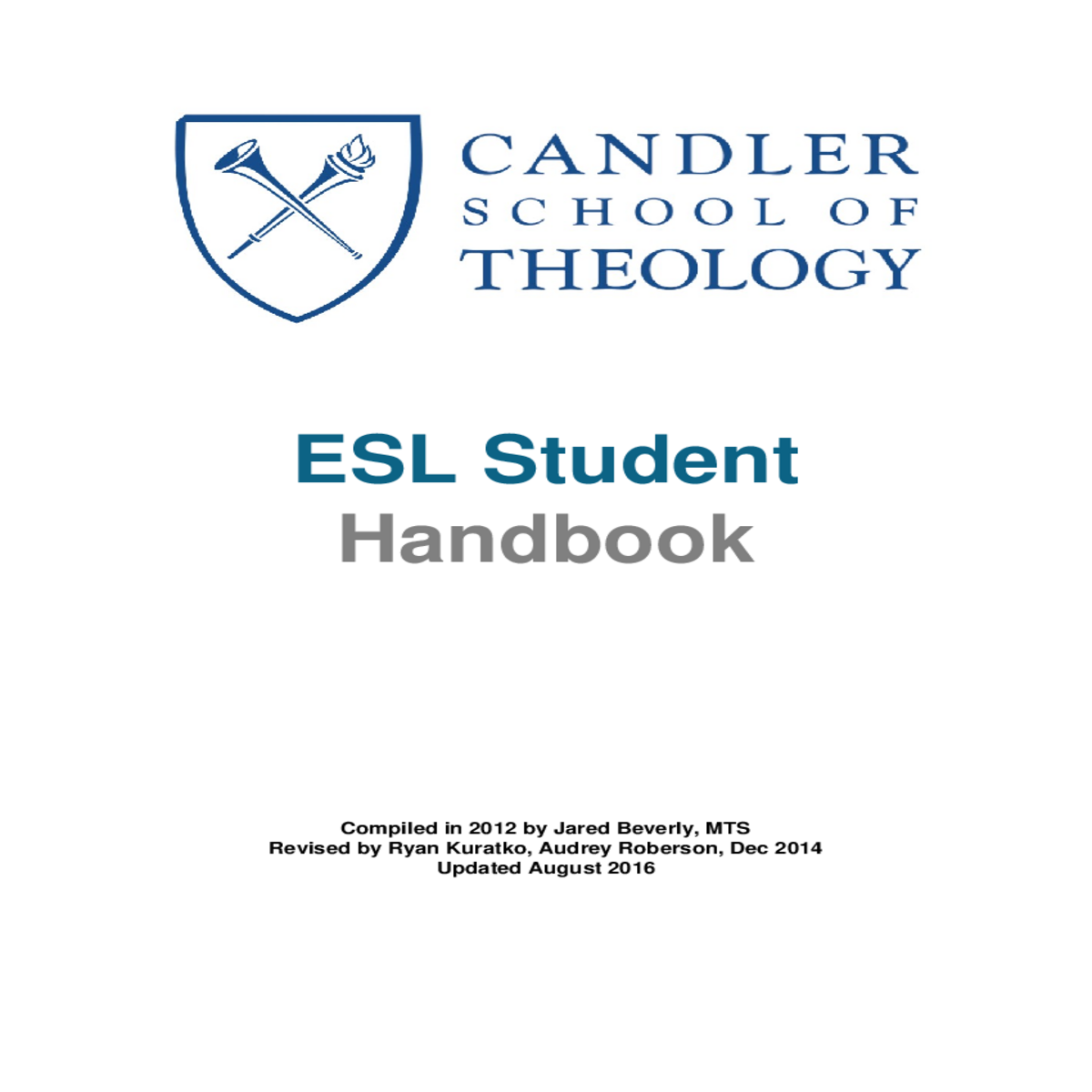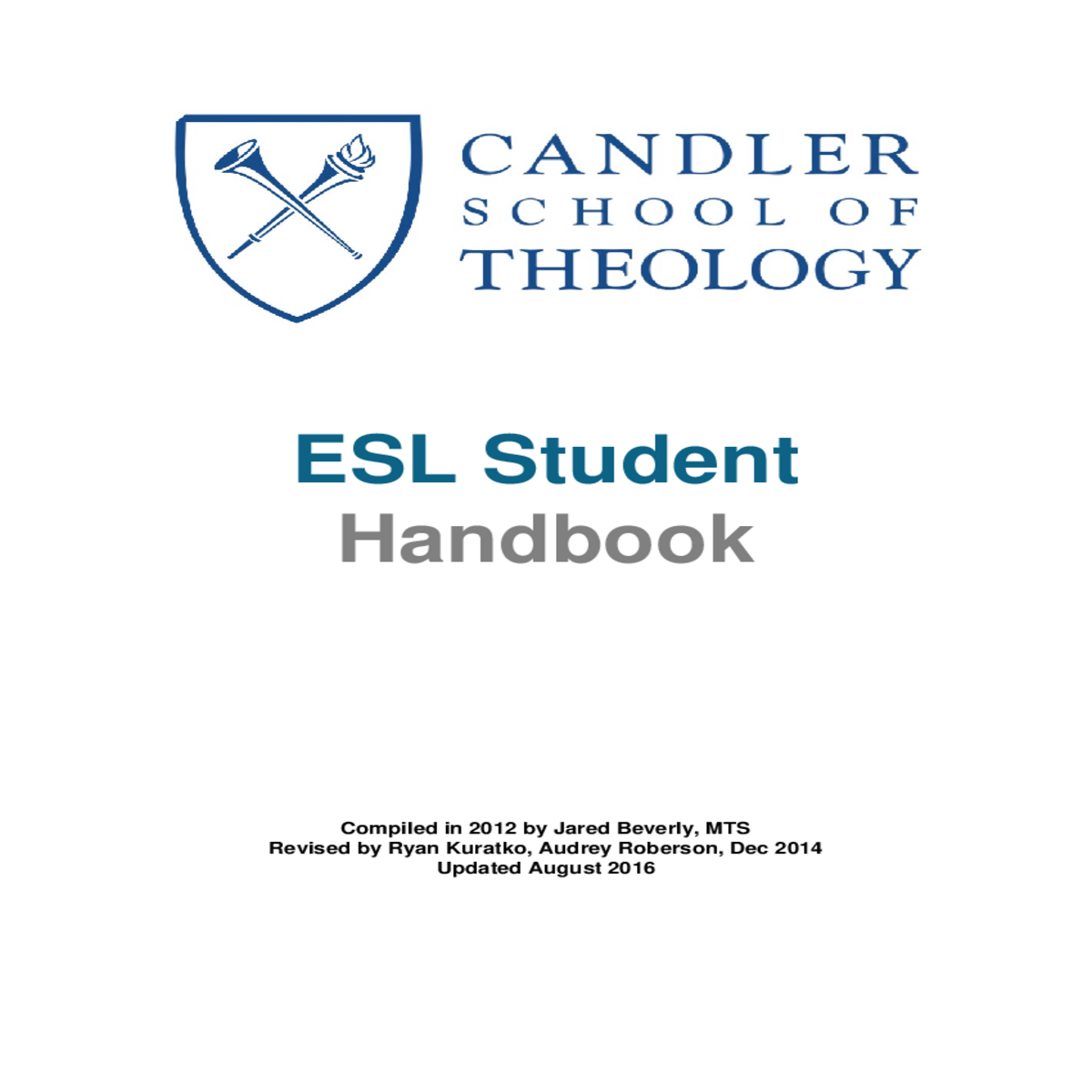Society of biblical literature (sbl) style citation

ESL Student
TABLE OF CONTENTS
WELCOME 1
conversation partners 9
STUDY TIPS 10
The Five-Paragraph Essay 13
GRAMMAR TIPS 18
FORMATTING AND CITATION 26
Formatting Papers 26
WELCOME
We encourage you to participate actively in your courses and to continue to develop your language skills. Your presence is a blessing to us and we want to help you succeed in any way we can.
Best wishes for a successful year!
ENGLISH LANGUAGE ASSESSMENTS
The oral skills assessment is offered to students early in the fall semester. This assessment, an oral proficiency interview with a trained rater, is designed to measure academic listening and speaking skills. The interview consists of three parts: warm-up questions, a read-aloud task, and questions about theology. Scores are posted as soon as available and are sent to each student and his or her faculty advisor. All students who do not receive a passing score on this exam are required to enroll in TESL 301: Oral Communication during the spring semester.
Appeal Process for Assessment Scores
The TESL instructor is Sarah Kegley. She may be contacted at sarah.n.kegley@emory.edu. The Assistant Director of Student Life and Academic Support is Audrey Hindes. Her email is ahindes@emory.edu, and she can be found in the Office of Student Programming in RARB 311.
ESOL WRITING TUTOR PROGRAM
Writing Center Policies (updated 12/15/2014)
Academic Skills Tutors are Candler students who are experienced writers with special training to assist international students. Tutors meet with international students in the Writing Tutor room (RARB 314) in the Office of Student Programming (RARB 311). Writing tutors are available to help any Candler international student with any Candler assignment. Also, tutors work in concert with the instructor for TESL300 and TESL301 classes to help students fulfill their required tutoring hours for those classes.
The Tutoring Session
A student will sit with the tutor while he or she reads the paper so that mistakes can be discussed and corrected together. The tutor will check for higher-order concerns, like the thesis, flow, and organization as well as lower-order concerns like grammar, vocabulary, punctuation, and spelling (although all papers should be spell-checked on a computer). The tutor may point out an unclear sentence or paragraph and discuss with the student a way to restate the idea more clearly. The tutor will not try to correct every error but rather try to empower the student to correct his or her own errors. Tutors do not proofread—they provide tools for students to become better writers.
Before bringing take-home exams to the Writing Center, you must obtain written permission from your instructor. It is the student’s responsibility to contact the instructor and secure his or her permission. The instructor should email the Assistant Director of Student Life and Academic Support specifying the course title and whether their permission extends to the entire class or only to a specific student. We will not help with a final exam until written permission is on file. In the unlikely event that the tutor and the student are taking the same course, the tutor will arrange for the student to work with another member of the staff. Naturally, we cannot help with content for a take-home test—only organization, thesis statements, grammar, spelling, punctuation, and the like.
Non-Academic Assignments
Meet the Staff
Kiya Ward: Kiya is a compelling speaker and an enthusiastic leader, who has a contagious hunger for God. After teaching in higher education for six years, and balancing ministry for four of those years, Kiya has chosen to pursue full-time ministry as a second year MDiv student at Candler. As a native of North Carolina, Kiya earned a Bachelor of Arts degree in Communication Studies from The University of North Carolina at Greensboro and received a Master of Arts degree in Communication Studies: International Public Relations from The University of North Carolina at Charlotte. Kiya has a passion for public speaking, service, travel and interpersonal communication. When she is not in class or working, Kiya enjoys spending time with family and working out. As a self-proclaimed “foodie” she also enjoys exploring Atlanta for delicious restaurants and scrumptious bakeries!
Linda Stephan: Linda is a second year MDiv student with a MA in journalism and a 10-year career in public radio. She's been edited a lot, and done a lot of editing. She loves that process! Everyone needs an extra set of eyes to make sure we're saying what we really mean to say. Linda is a tutor, but has been known to use the Writing Center herself for a little extra help on a paper (or two). She has also worked abroad, and understands how hard it can be to say what we mean in a second language. Linda is seeking ordination in the United Methodist Church and hails from the beautiful shores of Lake Michigan. She speaks Swedish and is a fan of Bollywood and K-drama.
 Sarah Kegley:
Sarah is the Instructor of the Theology English as a Second Language
courses in writing and speaking/listening. Sarah is currently the
Director of the ESL Credit Program at Georgia State University and
considers herself both an Applied Linguist and an
interculturalist.
Sarah Kegley:
Sarah is the Instructor of the Theology English as a Second Language
courses in writing and speaking/listening. Sarah is currently the
Director of the ESL Credit Program at Georgia State University and
considers herself both an Applied Linguist and an
interculturalist.
While Sarah's teaching career began in the public schools, in 1999, she
began teaching International students at Georgia State University, in
both undergraduate and graduate ESL writing programs. In addition, Sarah
lived for 5 years in Madrid, Spain, where she directed the American
Language and Culture Program for the International Institute in Spain, a
historical intercultural center which was founded to foster relations
between the US and Spain. She later took on the role of Director of
Student Life at Saint Louis University's Madrid Campus before moving
back to Atlanta in 2009.
Sarah grew up in the "highlands" of Virginia, and now lives in Atlanta's
Virginia-Highlands neighborhood. In her free time, she loves to read and
write; she is currently writing a memoir of her time in Spain. Sarah
considers any day that she gets to walk the dog for two hours, and later
read on the sofa with the cats, a very good day.
Writing Center Director/ADVANCE Instructor
conversation partners
Have an opportunity to practice informal oral English.
Have a cultural guide to U.S. and Candler practices.
STUDY TIPS
Lectures: Taking Notes
In class:
Write down the notes (obviously). This way, you're already beginning to process information.
Watch for clues from professor, such as tone of voice, volume, pauses, body language, writing on the board, and key words.
Color coding, correct spelling and finished sentences are impressive but not necessary.
Take notes only on one side of the paper, and use the other side for study comments.
Get used to a professor’s (good or poor) lecturing skills.
Go to other sources, e.g., your friends’ notes, textbooks, and reference books.
Fill in your notes with more information that you may have missed the first time but remember in your mind.
Reading Texts Quickly
Read selectively, not merely at a fast pace.
Read introductions, conclusions, and summary paragraphs.
Take notes while reading.
Participating in Class Discussions Well
Candler professors place significant weight on your participation in and contribution to in-class discussion. It is really hard to process information that comes from the teacher and different students (who speak with different accents) all at once. Fortunately, good participation does not depend on how often and how long you talk. Good participation means how deep and thoughtful your comments are. Your best help is your diligence in reading what is assigned.
Test-Taking Strategies
Make sure you understand the information as you are learning it. That way, you won’t have to re-learn it or have to cram a great deal of information at one time.
Read and study information in meaningful chunks (by chapters or units) so that you'll be able to mentally store and retrieve information easily.
Use mnemonic techniques to memorize lists, definitions, and other specific kinds of information.
Form a study group with other students in your class to discuss and quiz each other on important material. This will add other perspectives and help to complete your study if you tend to be either a detail-oriented or big-picture-oriented learner.
Get the big picture -- survey the entire test before you answer any questions. This will help you to get an overview of what's expected and to strategize how you will take the test.
Take a few deep breaths to relax tense muscles. Repeat this process throughout the test.
Look for the central idea of each question. What is the main point?
Try to supply your own answer before choosing an alternative listed on the test.
starts with a direct response to the question,
mentions the topics or areas described in the question,
Write legibly. Leave some space so you can add to your answer later.
Proofread your essay. Check for grammar, punctuation, spelling, etc.
The Five-Paragraph Essay1
An essay is a literary composition that expresses a certain idea, claim, or concept and backs it up with supporting statements. It will follow a logical pattern, to include an introductory paragraph (including the claim), a body (support), and a conclusion (summary and implications).
This brief guide presents a common structure for essays. The five-paragraph essay is a common form that most American students learn in high school. Its organization and contents appear as follows.
Introduce the topic. The next few sentences should explain your first statement, and prepare the reader for your thesis statement.
The old yellow bus was reported to be the very one that sparked the civil rights movement, when a young woman named Rosa Parks. . . .
It took incredible courage for an African American woman to make such a bold stance in 1955 Alabama.
Evidence: For every point you make, offer evidence to support it. Evidence can include citations but will mostly be your own explanations.
Summary: The fifth and final paragraph will summarize your main points and re-assert your main claim. It should point out your main points, but should not repeat specific examples.
No new information: New information is best served by appearing in the body paragraphs. The conclusion does not need additional evidence but rather a summary of the evidence that has already been presented.
Developing a Strong Thesis2
The most important sentence in any paper will be the thesis. Any good paper has a good thesis, which needs to be both debatable and narrow, and a good thesis can take a number of different forms.
The Thesis Statement or Main Claim Must Be Debatable
This is an example of a debatable thesis because reasonable people could disagree with it. Some people might think that this is how we should spend the nation's money. Others might feel that we should be spending more money on education. Still others could argue that corporations, not the government, should be paying to limit pollution. Another example of a debatable thesis statement is:
America's anti-pollution efforts should focus on privately owned cars.
There are several reasons this statement is too broad to argue. First, what is included in the category “drugs”? Is the author talking about illegal drug use, recreational drug use (which might include alcohol and cigarettes), or all uses of medication in general? Second, in what ways are drugs detrimental? Is drug use causing deaths (and is the author equating deaths from overdoses and deaths from drug related violence)? Is drug use changing the moral climate or causing the economy to decline? Finally, what does the author mean by “society”? Is the author referring only to America or to the global population? Does the author make any distinction between the effects on children and adults? There are just too many questions that the claim leaves open. The author could not cover all of the topics listed above, yet the generality of the claim leaves all of these possibilities open to debate. A more narrow or focused thesis might be:
Illegal drug use is detrimental because it encourages gang violence.
America's anti-pollution efforts should focus on privately owned cars because it would allow most citizens to contribute to national efforts and care about the outcome.
This thesis narrows the scope of the argument by specifying not just what the focus of a national anti-pollution campaign should be but also why this is the appropriate focus. Qualifiers such as “typically,” “generally,” “usually,” or “on average” also help to limit the scope of your claim by allowing for the almost inevitable exception to the rule.
Claims about value: These are claims made about what something is worth, whether we value it or not, how we would rate or categorize something. Example: Global warming is the most pressing challenge facing the world today.
Claims about solutions or policies: These are claims that argue for or against a certain solution or policy approach to a problem. Example: Instead of drilling for oil in Alaska we should be focusing on ways to reduce oil consumption, such as researching renewable energy sources.
GRAMMAR TIPS
Verb Tenses3
| Tense | Example |
|---|---|
| present perfect (used for indefinite past time meanings, especially in introductory statements; indicates that an action is completed but has continuing effects in the present time) | They have been there before. |
| simple past tense (describes actions or activities that began and ended in the past) | I quit smoking. |
| past perfect (describes actions or activities that were completed before another action or activity in the past) | The runner had started before the gun sounded. |
| past progressive (describes actions or activities that happened at the same time in the past; the past progressive is rarely used in simple sentences; it is usually used in contrast with another verb in a complex sentence) | She was waiting for winter to come, when suddenly snow appeared. |
Present Time
| Tense | Example |
|---|---|
| present progressive (describes actions or situations in progress at the moment of speaking) | I am running out of time. |
| simple present | I go to school every day. |
Future Time
The Semicolon and the Colon
Between closely related independent clauses not joined with a coordinating conjunction.
When related independent clauses appear in one sentence, they are ordinarily connected with a comma and a coordinating conjunction (and, but, or, nor, for, so, yet). The conjunction expresses the relation between the clauses. If the relation is clear without the conjunction, a writer may choose to connect the clauses with a semicolon instead.
When a transitional expression appears between independent clauses, it is preceded by a semicolon and usually followed by a comma.
Many corals grow very gradually; however, the creation of a coral reef can take centuries.
Common Misuses of the Semicolon
Between a subordinate clause and the rest of the sentence.
*All my favorite film stars have Websites; John Travolta, Susan Sarandon, Leonardo DiCaprio, and Emma Thompson. (use colon instead)
Between independent clauses joined by and, but, or, nor, for, so, or yet.
My roommate is guilty of two of the seven deadly sins: gluttony and sloth.
Consider the words of John F. Kennedy: “Ask not what your country can do for you; ask what you can do for your country.”
5:30 P.M.
The ratio of women to men was 2:1 .
*Some important vitamins and minerals found in vegetables are: vitamin A, thiamine, niacin, iron, potassium, folate, and vitamin C. (omit colon instead)
Between a preposition and its object.
Prepositions
To express a single point in time, English uses on, at, and in.
On is used with days.
The movie starts at 6 p.m.
In is used with other parts of the day, with months, with years, with seasons.
Extended Time
To express extended time, English uses the following prepositions: since, for, by, from-to, from-until, during, in, within
I watch TV during the evening. (For some period of time in the evening.)
We must finish the project within a year. (No longer than a year.)
I left your keys on the table.
She was waiting at the corner.
To express notions of an object being lower than a point, English uses the following prepositions: under, underneath, beneath, below.
The rabbit burrowed under the ground.
To express notions of an object being close to a point, English uses the following prepositions: near, by, next to, between, among, opposite.
She lives near the school.
The bathroom is opposite that room.
To Introduce Objects of Verbs
I'm looking at the computer monitor.
We rejoiced at his safe rescue.
My contribution to the article consists of many pages.
He came home smelling of alcohol.
For: call, hope, look, wait, watch, wish
Did someone call for a taxi?
If you wish for an “A” in this class, you must work hard.
*I am looking forward to go to the party.
Articles4
I have a relationship/some relationships. (count—it can be made plural)
I have a pleasure/some pleasures that lam unwilling to give up. (count and non-count—it can be made plural in limited situations)
names of subjects of study (ESL, biology, mathematics)
abstractions (happiness, justice, luck)
diseases (measles, mumps, smallpox)
Singular count nouns must always have a determiner, such as an article. For generic meaning, non-count nouns never have an article or a determiner
generic singular count nouns
My mother is a teacher.
He lives in Alaska.
generic plural count nouns
Use the for
subsequent mentions
The same research was cited repeatedly throughout the conference.
shared/common knowledge or unique reference
Some of the people were affected by the smoke.
names of theories, effects, devices, scales and some other names
FORMATTING AND CITATION
Formatting Papers
Society of Biblical Literature (SBL) Style Citation
Talbert, Charles H. Reading John: A Literary and Theological Commentary on the Fourth Gospel and the Johannine Epistles. New York: Crossroad, 1992.
Book by Two or Three Authors
7 Bernard Brandon Scott et al., Reading New Testament Greek (Peabody, Mass.: Hendrickson, 1993), 53.
9 Scott et al., Reading New Testament Greek, 42.
Egger, Wilhelm. How to Read the New Testament: An Introduction to Linguistic and Historical-Critical Methodology. Translated by P. Heinegg. Peabody, Mass.: Hendrickson, 1996.
Book With One Editor
45 Edward Schillebeeckx, The Schillebeeckx Reader (ed. Robert J. Schreiter; Edinburgh: T&T Clark, 1986), 20.
55 Schillebeeckx, The Schillebeeckx Reader, 30.
Attridge, Harold A. “Jewish Historiography.” Pages 311–43 in Early Judaism and Its Modern Interpreters. Edited by R. A. Kraft and G. W. E. Nickelsburg. Philadelphia: Fortress, 1986.
Multi-Volume Work
7 Blake Leyerle, “John Chrysostom on the Gaze,” JECS 1 (1993): 159–74.
23 Leyerle, “John Chrysostom,” 161.
Klosinski, Lee. E. “Meals in Mark.” Ph.D. diss., The Claremont Graduate School, 1988.
Encyclopedia or Dictionary Article
BIBLIOGRAPHY
Benson, Beverly, and Patricia Byrd. Applied English Grammar. Boston, MA: Heinle & Heinle, 1992.
The Chicago Manual of Style. 16th ed. Chicago: University of Chicago Press, 2010.
Lunsford, Andrea A., and Karen J. Lunsford. “‘Mistakes are a Fact of Life’: A National Comparative Study.” College Composition and Communication 59.4 (2008): 781–806.
Pickert, Joseph P. American Heritage Dictionary of the English Language. Boston, MA: Houghton Mifflin, 2000.
Weida, Stacy, and Karl Stolley. “Developing Strong Thesis Statements.” Purdue Online Writing Lab. 2 September 2011. <http://owl.english.purdue.edu/owl/resource/588/01/> (11 January 2012).
Much of the material in this section has been adapted from Byrd and Benson, Applied English Grammar, 214–231, and John M. Swales and Christine Feak, Academic Writing for Graduate Students: Essential Tasks and Skills (2nd ed.; Ann Arbor, MI: University of Michigan Press, 2004), 221–234.↩︎





